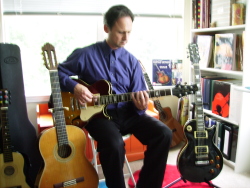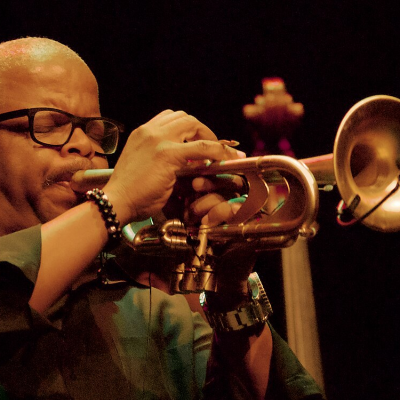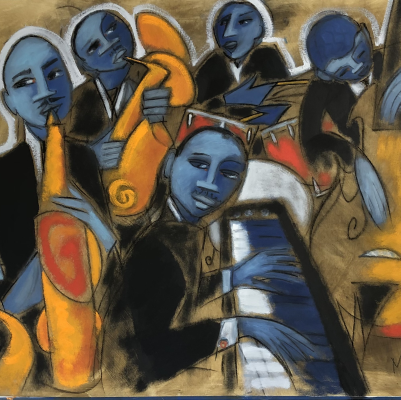“Intergalactic Language,” a short story by James E. Guin, was a finalist in our recently concluded 42nd Short Fiction Contest. It is published with the permission of the author.
Intergalactic Language
by James E. Guin
_____
I was playing my weekly gig at Café Reinhardt when Bella, one of the waitresses, whispered in my ear, “They want you out back.”
She had disturbed me from a zone. I had been through all of my arrangements and was improving on the chords to “Minor Swing.”
“They?” I asked.
She shrugged her shoulders. Straight to the point, no small talk, Bella was my kind of gal. In the second it took to place my guitar on my guitar stand a million thoughts circled around in my mind. Did Chad, the drummer, want to borrow money again? Had the musician’s union caught on to the fact I wasn’t paying my dues? Another one of the agent Jimmy’s scams? Groupies? Oh yeah, jazz musicians haven’t had groupies under the age of forty-five since the 1940s.
I stood up, and as Bella was strolling to a table near the front door, she said, “Take your guitar.”
Ah, nothing complicated just someone wanting to test out my chops before a gig. People can be peculiar when it comes to inviting musicians into their home. They want to meet you, form a relationship, and get the feel for the atmosphere you create. They like to know what they are paying for. I placed my guitar in its case and walked through the kitchen.
I opened the back door to the cafe and a tour bus with the engine running was parked across the street. All these eco-friendly vehicles and so many are still running on fossil fuel. With a generic mountain scene painted on the side, it looked like something one of those old bluegrass bands would have toured in. I’ve seen vintage pictures on the Internet. The door opened and a man in a black Armani suite and shades — the whole nine yards — stepped down onto the street. His suit was too new, too nice, and too expensive for him to be a musician. He motioned for me to cross the street.
This must be something big, I thought.
“Taking me on a tour?” I asked.
“Something like that,” he said.
As I was stepping onto the bus, he said, “After tonight, you will be the most famous musician in the galaxy.”
That was a lame yarn, man. Ever since the Nuages landed people were making space jokes. Nuages — they were from a planet in the Sagittarius Star Cloud, so that was what we called them.
Two suits waited at the top of the stairs. The one on the right motioned for me to follow him and the other one trailed behind. They were making me nervous. I didn’t have anything valuable and no one would go to all of that trouble for a 40,000 credits antique Gitane DG-310 that I got for at a pawnshop for 500 credits. The pawnshop owner had no clue. To me it was priceless, but to the rest of the world holo-screens and virtual sets are current treasures.
The hallway felt like it stretched to about the center of the bus. The suit in front knocked on the door. Someone on the inside opened it. He moved out of the way, motioned for me to step through, and what I saw next was unlike anything I had ever imagined. Two Nuages were levitating about half a meter off of the floor in the back of the room. I had read about them on the Internet, media streams were blowing up about them, and I had watched shows and documentaries on them. Everyone on Earth had. There were three different spacecraft that had landed on Earth passing by on an exploration of the Milky Way.
Like some of the videos I had seen, they sat crossed-legged on some flat, clear glass type of floating plane, but I couldn’t see any equipment that made it levitate. Their skin had a dark pinkish color to it. They had head-tentacles, but the rest of their body was like a female human body — a nice female specimen from our species.
Something was floating in the center of the room. I noticed it only because everything in the room reflected off it.
The one stage-right started humming a melody in major and minor thirds.
“Please sit,” the one stage-left said in perfect anchor-babe English.
She pointed at the floating plane in the center of the room. I laid my guitar case on the floor. Half expecting to fall on my buttocks, I sat on it like you would sit on a ledge or the high rise next to a sidewalk. After I felt I was in a firm sitting position, it adjusted to a comfortable height. An ideal comfortable height like it was reading my mind.
“This is —–,” the one stage-left said.
Trying to repeat the sounds in my mind, I squinted my eyes.
She sensed my confusion and said, “After much training some English speakers could reproduce and recall most of the sounds of my owner’s native language, and yes it is a tonal language.”
“My owner? Are you a slave?” I asked.
“I am equivalent to Artificial Intelligence on Earth,” she said.
As if rehearsed, the A. I. held her arm out and said, “My owner, —–, is female of the species from planet——which is in the Sagittarius Star Cloud near the center of our galaxy which you call the Milky Way. She has traveled 10,400 light years exploring and gathering data on life forms in this galaxy that we share. You have been recommended to us, and we would love to hear your music.”
Recommended by whom? I thought as I took out my guitar and tuned it.
I have played for governors, the pope, various members of congress, and the speaker of the House of Representatives, and they’re the only ones who would have connections so high up.
What should I play for beings who have traveled 10, 400 light years across the Milky Way: “Nuages” (That would be ironic.), “Night and Day”, “All The Things You Are”, “St. Louis Blues”…Yeah, everyone in the galaxy should know “St. Louis Blues.” It wasn’t as wild as Django’s, but I began an arrangement of “St. Louis Blues” that I had learned many years ago. I wasn’t nervous. I was freaking out, and I needed a comfort tune. It was straight and stiff, and I kept playing dead notes and making the strings scratch and buzz.
I stopped and all I could cough up was, “I’m sorry.”
The Nuage and the A. I. conversed in their musical language.
“Perhaps you are tired,” the A. I. said.
“No, this is too much for me. I’m just nervous,” I said.
The owner said something that covered at least two octaves.
“It might be helpful to perform music that is meaningful to you,” the A. I. translated.
I thought for a few minutes and then said, “I will improvise for you. That might calm my nerves.”
Faking it has always been my thing.
“In Earth music, what is improvise?” the A. I. asked.
Earthlings have asked me that many times.
“I will make up, create, invent, compose music on the spot. Right now, I mean,” I said.
The owner said something, but this time the pitches were back to major and minor thirds.
“In our culture only those who are gifted can compose music,” the A. I. translated.
“Well, you could say the same about Earth,” I said and began to collect my thoughts so that I could redeem my prior performance.
After the mess I had just created, my right hand thumb brushing across the strings felt triumphant. So much power in such a small stroke — to most it would appear insignificant, but the precision of the manipulation of sound felt like a miniature universe contained in a sixteenth of a beat. The scale leading from the first chord to the second chord was only a scale, but it fit. An up stroke on the second chord sounded backwards, but would it sound backwards to the Nuages. Maybe their music sounds backwards to us. Their music and our music may be as different as Cecil Taylor and Django Reindhardt. But considering all of the jazz that’s exploded into existence since those two giants, how different are Cecil and Django?
I looked up and saw that she had her eyes closed, listening. The A. I. was staring at me, but her gaze gave me the sense she was listening and enjoying my music. The next three for four minutes were lost in the moment. Scales, chords, melody and accompaniment lost to space and time. All of the fears of this mystifying environment dissipated into music that emerged from an unidentifiable place in my subconscious.
I ended on “the one” and let it ring a full twelve beats. But would that even mean anything to her? Would she feel disjointed or strange?
As soon as I placed my right hand on the strings to finalize the scarcely audible sound to my human ears, she opened her eyes.
With more excitement in her voice than before, a series of pitches rose and fell, crescendo and decrescendo, she made music that was more beautiful than anything I had ever created.
“This music demonstrates a fundamental grasp of physics as well as evoking a wide spectrum of human emotions,” the A. I. translated.
“Thank you. Do you want me to play again so that you can record?” I asked.
“Everything that I see and hear is recorded. It will be viewed when we return,” the A. I. said.
That was an unfathomable thought: my music traveling across the galaxy.
“May I hear music from your planet or other planets where you have traveled?” I asked.
“As unfair as it may seem, we have decided not to share our findings with other species. We do not know what consequences that may convey,” the A. I. said.
She began her musical speech.
“We thank you for your gift and for your time,” the A. I. translated.
From the side, one of the suits appeared in my vision and motioned for me to stand up and leave. The next thing I knew I was rushing through the door and down the hallway. The two suits who had escorted me in were leading me out.
I looked at the original suit and said, “Most famous musician in the galaxy, huh.”
“There will be a sufficient amount of credits in your account for confidentiality and time,” he said.
“Thanks,” I said, not really understanding the full weight of that statement.
He turned around, stepped onto the bus, and a few seconds later they drove off. It was only then that I noticed I had gotten off on the opposite side of the street facing the café. We had driven around the city.
Dazed, I walked though the kitchen of Café Reinhardt and into the front. The place was empty except for a slick couple walking out the front door. I started gathering my equipment.
“You disappear like that again and Django’s going to call Jean,” Bella said.
Django was the owner, and Jean was this Gypsy Jazz poser who couldn’t play his way out of a paper bag.
“Bella, look, tell Django I’m sorry. That was a huge gig. I don’t expect that type of opportunity to come along again in my lifetime,” I said.
“Well, I hope it was worth it. Django’s furious, but I told him if you go I go,” she said and started stacking chairs on top of the tables.
That Bella’s always looking out for me. My kind of gal.
__________

James E. Guin’s fiction has appeared in Daily Science Fiction, Perihelion Online Science Fiction Magazine, T. Gene Davis’s Speculative Blog, MetroMoms: Metro Fiction, Untied Shoelaces of the Mind, and Alternate Hilarities Anthology Volume 1. He received an Honorable Mention in the 2nd Quarter of the 2014 L. Ron Hubbard’s Writers of the Future contest and second place in Jenny Magazine Speculative Fiction Contest 008. For more about James E. Guin please visit jameseguin.wordpress.com


































